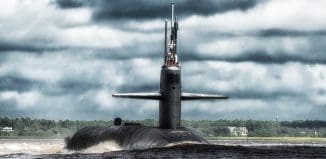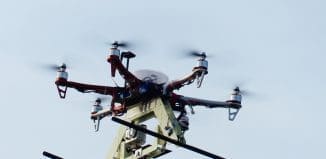Global Executives Toured the Israeli Defense Industries
This post is also available in:  עברית (Hebrew)
עברית (Hebrew)
By iHLS NewsDesk
The mosquito and the heron, the big bird and the panther, the mule and the dragonfly: As luck would have it all of these animals are also unmanned vehicles created by the Israeli defense industries.

A short explanation:
- The Mosquito – a micro UAV by IAI, 500 grams and a camera
- The Heron – A much bigger UAV
- The big bird – a nickname for the biggest UAV being developed in Israel
- The Air-Mule – a new revolutionary concept for an unmanned chopper
- The Dragonfly – the IDF code name for the Air-Mule
These are some of the “unmanned” animals presented yesterday to a group of guests, who came to Israel in order to attend the Autonomous Unmanned Systems and Robots (AUS&R) conferences in Rishon-Lezion. They came from eight countries (France, United States, Estonia, the Netherlands, South Korea, Peru, Switzerland and Lithuania), businessmen, engineers and members of the media, people who know something about UAVs. Two representatives from Finland flew from Helsinki, from minus 10 degrees Celsius directly to Tel Aviv’s 34 degrees Celsius.

The IAI visitors’ center for overseas customers in Lod showed the guests a 3D-film explaining how to manage a war – and win – with the products of Israel’s largest industry (16 thousand employees, about 80% of its production goes to export and 75% are military products), with the arrow-2 and Arrow-3, spacecraft in orbit, LORA and HAROP missiles and the AWACS aircraft, the Galaxy executive jet, and of course the main theme of the visit – the unmanned systems.
The guests walked along the assembly line and saw the large and small vessels – the ‘Mosquito’ a soldier can hold in one hand, 45-minute operational flight time, transmitting to a laptop held by the soldiers, transmission of video material in real time. The Heron-1 was seen on live display, and yesterday they heard a few details about the biggest UAV – the HERON TP, called “Eitan” by the IDF, which weighs five tons and has a wingspan of 26 meters, such as Boeing 737, can carry a payload that weighs a ton (1,000 Kg). An unmanned monster.

The guests featured two UGVs, unmanned ground vehicles, the G-Nius (which also starred in the live show) and the Rex, which appeared in the ground exhibition. The ‘Rex ‘ promises to be a marketing hit: a squad of soldiers marching on the battlefield, the soldiers with only basic gear strapped to their backs while the ‘Rex’ rides with them, carrying all their equipment – weapons, ammunition, water and logistics supplies. It can also carry casualties. Equipped with a GPS navigation system, it can be driven by cable, and can also be used to position a weapon. The guests raved about the robotics innovations from the civilian aircraft industry – the “TAXIBOT”, an autonomous vehicle designed to transport civilian aircraft at the airport grounds after landing and transfer them to a parking spaces, all without human intervention.
Along the drone production line of IAI’s MALAT factory, the plant’s managers told the guests that currently, about 50 customers around the world operate IAI UAVs , and some army UAV operators in Afghanistan also use Israeli equipment. Indeed, we saw at the UAV production line a Luftwaffe UAV decorated with a black cross, which operates in Afghanistan and was sent to Israel for maintenance. Among the UAV exports, the Heron is the sales record holder – about 20 clients, including civilian customers. Indeed, there was a Heron painted blue which had the marking of an Israeli aircraft – UMF – X 4, the UAVs for civilian use must carry identification signals as if they were manned civilian aircraft. On the wall of the giant hangar where the production line was, there was a souvenir from the past – the “Scout” UAV , the first UAV manufactured by IAI and the first operational tool in the Air Force, retired after 25 years of service. From above the Scout is watching its successors – the ‘Searcher’ and the ‘Heron’.
A small glimpse at one of the Hangars nearby, and we are told that it is being groomed for a new purpose – starting to produce the wings for the future F-35 fighter jet, under contract with the U.S. manufacturer.
At the Jet production line we meet the Galaxy G-280, the luxurious manned aircraft designed for the world’s richest, costing 25 million dollars and capable of making the way from Paris to New York without a stop, where world leaders can sit comfortably, sipping champagne and watching movies on a big screen – carrying from 8 to 12 passengers.
IHLS – Israel Homeland Security
The next stop – Aeronautics factory in Yavne. We are welcomed by a huge picture showing a butler in a black suit and bow tie, holding a silver tray with a small drone, and the inscription: “How would you like your drone? Supplied ahead of time, cheaper and tailored to your requirments”.

Managers at Aeronautics , Dvir Tzur and Felix Frisch , report that Aeronautics had sold UAVs to 50 customers in 45 countries on five continents . The Netherlands Police, for example, uses this tool to keep an eye from above on football fields and locate hooligans. The most common UAV bearing the symbols of Aeronautics is the Orbiter, operated successfully in many countries. Weighing 10 kg, it can stay aloft four hours, range up to 30 km, carry a Day / Night camera, laser equipment, launched from the ground or from vehicles. The Orbiter is also used as an airborne forward observer by artillery officer. No wonder that this tool works in the deserts of Afghanistan and snow-filled mountains of Finland. With this northern country an agreement was signed to sell a large number of drones, only after Aeronautics engineers responded to the operational requirements of the Finish customers – ability to operate at minus 20 degrees Celsius in the winter of Finland, and the ability to land at a precise point in a clearing in the vast forests. The advanced model ‘Orbiter 3″, has opened the second demo at the air show in Rishon Lezion, can stay aloft for seven hours, range of 100 km, and its belly payload (5 kg) is rich with equipment , manufactured by Controp, acquired by Aeronautics .
Company officials explained that the plant does not have automatic production lines – all production and assembly is manual. This method provides flexibility, you can change and replace every stage in production, without having to invest millions in automated production lines. Each UAV – crafted by Hand.

The last stop on our tour, before the guests return to their home countries, was at URBAN AERONAUTICS, also in Yavneh, where a surprise awaited them: the guests from abroad were given detailed explanations and saw with their own eyes an unmanned aircraft that is still at the stage of flight tests, still no customers, and now looking for investors to perform test flights in the Negev next year. But the news is that the Ministry of Defense and the IDF are interested, and the IDF has already given it a name – “Pereira” (Shafririt). Meanwhile, Dr. Rafi Yoeli – the company’s CEO – uses the name “AIR MULE”. The Mule was there, and was also presented at the booth in Rishon Lezion – an unmanned helicopter; both rotors (top and back) are hidden inside its body. The Idea is to avoid the dangers threatening helicopter, manned or unmanned, the clash between the rotor and an obstacle, mountain, wall, tree cliff. The Mule, on which Dr. Rafi Yoeli and his dedicated employees are working for nearly 10 years, is designed to fly in creeks, city streets, next to big buildings, bringing supplies or cargo (capable of providing hundreds of pounds of equipment to soldiers), evacuating from the battlefield up to two casualties and transfering them the a field deployed clinic for medical treatment.
Maritime use of such tools are particularly important: the world’s fleets are currently searching for an aircraft capable of lifting off and land vertically on-board medium and small ships. On such ships, the use of helicopters with external rotors have been difficult – landing and taking off, especially under severe sea conditions.
If the Mule is operationally approved, it will be a revolution in aviation, as this is the first time an unmanned system flies living people. Dr. Yoeli says that NATO established a special committee to discuss this issue, the U.S. military and the IDF Medical Corps are also involved, and the same committee concluded that a legal solution to flying live people is possible, and there should be strict standards to operate.

The Mule is made mostly of composite materials (Kevlar, carbon fiber, titanium, etc.), driven by four FLY-BY-WIRE channels , with size of a military Hummer, weighs 770 kgs, equipped with two motors, two payloads on the sides and one along the centerline, including laser and various sensors. The tool is capable of doing what no regular helicopter pilot would not dare – to fly very low – under the radar detection and flying in antiaircraft environment.
The Mule is designed for civilian uses too, derived from the nature of its special flight as penetration into active nuclear reactor zones, and following the Fukushima reactor disaster in Japan there was some interest. Engineers have designed special arms that will be installed on the Mules, and can perform repair work or purification to damaged nuclear reactor.
URBAN CEO, Dr. Rafi Yoeli, Concludes: “We develop here in Yavneh an entirely new category of aircraft . There was no such thing in the past. In the 60s the U.S. planned an aerial Jeep, but the idea failed. Then came films and harmed us, making people believe that flying cars belong to science fiction. But we made the first tool already flying successfully and produce now the second Prototype. Simultaneously, we know today there is awareness to this kind of tools, also as a lesson learned from the Second Lebanon War: helicopters were damaged in Lebanon and it was very difficult to evacuate the wounded from the battlefield because of the terrain and difficulty to land helicopters. Our tool is the solution, and we are pioneers in this field. it’s hard work, many and complex technologies are involved, and it’s definitely not a project for beginners but for skilled professionals. Our goal is to begin test flights in the Negev in 2014 and to be operational within five years”.






























